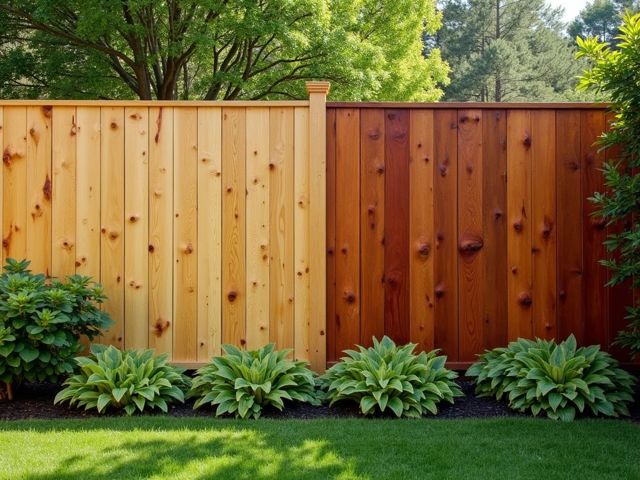Cedar offers cost-effectiveness and aesthetic flexibility with its lighter color, while redwood provides superior durability and a distinctive rich hue, making it ideal for those seeking minimal maintenance and natural beauty. Both are eco-friendly, but redwood is denser and more expensive, offering greater strength and longevity.
Visual Appeal: Color and Aesthetic Choices
Insights from What type of wood should I use for a wood fence? simplify the comparison between cedar and redwood.
Homeowners often consider visual differences when choosing wood for a fence. Cedar’s natural yellow undertone offers flexibility in staining and customization, appealing to those wanting a personalized look (Pickets Creative Fence Painting Tips). In contrast, redwood is noted for its warm reddish-brown color, ideal for those who appreciate a natural appearance and minimal maintenance requirements.
Both wood types offer distinct aesthetic benefits, helping homeowners make choices aligned with their design preferences.

Eco-Friendliness and Sustainability Factors
Cedar and redwood stand out as eco-friendly choices due to their natural qualities and responsible sourcing. They are 100% natural and carry Forest Stewardship Council certification.
Cedar
- Sustainability: Responsible harvesting with minimal environmental impact.
- Environmental Benefits: Natural resistance to rot, reducing the need for harmful chemical treatments.
- Cost and Maintenance: More affordable and easier to work with, offering customizable appearances without harming the environment (Pickets Guide to Exotic Hardwoods).
Redwood
- Strength and Longevity: Known for durability and natural insect repelling properties.
- Sustainable Harvesting: Carefully managed harvesting practices support resource sustainability (Pickets Eco-Friendly Wood Fencing Options).
Choosing between cedar and redwood depends on personal preferences, focusing on budget, appearance, and desired longevity.
Durability and Longevity: Which Lasts Longer?
When it comes to durability, redwood tends to be the sturdier choice with 23% more strength than cedar. Its density and protective oils make it resilient against the elements, appealing to those seeking a long-lasting fence.
Cedar offers commendable longevity when maintained properly, lasting up to 40 years. Its popularity persists in areas like Central Texas due to its affordability.
The decision between cedar and redwood should consider personal priorities regarding durability and budget (Pickets Choosing the Right Wood Fence).

Budgeting Your Fence: Cost Comparison
Understanding cost differences is key in planning fence projects, especially in regions like Texas.
Cedar:
- Costs $2 to $4 per linear foot, making it more budget-friendly.
- Offers durability with natural resistance to rot and decay.
- Provides aesthetic flexibility for painting and maintenance.
Redwood:
- Ranges from $8 to $12 per linear foot, representing a higher initial investment.
- Known for its attractive, robust appearance, reducing the need for frequent maintenance (Pickets Wood Fence Cost Per Foot).
Cedar is recommended for those balancing cost with durability, while redwood offers a more luxurious appearance for a higher investment.

Maintenance and Care: Keeping Your Fence Pristine
Maintaining a fence involves several key steps. Regular cleaning with soap, water, and hydrochloric bleach ensures cleanliness, while redwood may require specialized primers for painting due to its oils.
Routine inspections are necessary to address damage early. Applying natural wood brighteners or protective finishes helps maintain the original redwood color. Cedar benefits from regular sealing and staining (Pickets How to Stain Your Fence).
Keeping vegetation away is crucial to prevent moisture-related deterioration. Regular trimming enhances both the appearance and longevity of the fence.

FAQ
What are the visual differences between cedar and redwood fences?
Cedar offers a yellow undertone for color customization flexibility, while redwood provides a more natural reddish-brown hue.
Are cedar and redwood eco-friendly choices for fencing?
Yes, both are eco-friendly, 100% natural, and often Forest Stewardship Council certified.
How does the durability of redwood compare to cedar?
Redwood is stronger than cedar, with better resistance to rot and insects, offering longer lifespan and less maintenance need.
What are the cost differences between cedar and redwood?
Cedar costs $2 to $4 per linear foot, whereas redwood ranges from $8 to $12 per linear foot.
What maintenance is required for cedar and redwood fences?
Both require regular cleaning. Cedar benefits from sealing and staining, while redwood may need primers for painting due to natural oils.
What are the benefits of using cedar for a wood fence?
Cedar is cost-effective, allows for aesthetic flexibility, and naturally resists rot.
Why might someone choose redwood for their fencing project?
Redwood is chosen for its strength, appealing appearance, and minimal maintenance due to its natural properties.

